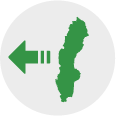
Future customs procedures
How your means of transport and goods make their way out of Sweden

This page contains a summary of the customs procedure logistics goods for goods and a means of transport leaving Sweden when using an entirely electronic information exchange system.
While goods and a means of transport leaves Sweden and the EU, an electronic exchange of information takes place.
This exchange of information follows multiple mutually dependant steps, each with its own purpose. This exchange will be made between several actors and various points in time.
Customs supervision is a collective term to describe actions taken by Swedish Customs, with regard to goods that are imported, stored, exported or re-exported.
From the time when the goods enter the customs territory of the European Union, they are subject to customs supervision and may thus be inspected by Swedish Customs. The goods will be placed under customs supervision for the time it takes to establish their customs status and until the time when the goods are cleared for free circulation, re-exported or destroyed.
Union goods are placed under customs supervision if they have been declared for exportation, internal transit within the Union of outward processing. They will be subject to customs supervision from the time when their customs declaration is approved until the time when they are taken out of the customs territory of the European Union, transferred to the State, destroyed or their customs declaration is declared void.
When goods are placed under customs supervision, the owner, or any other person, may not interact with the goods in any manner without permission from Swedish Customs. The purpose of this is to ensure that the goods are not modified, distributed or withheld from any inspections. This minimises the risk of tax or customs duty avoidance, but also the risk of restricted goods entering the European Union without authorisation.
Swedish Customs is authorised to confiscate non-Union goods as part of its supervisory duties. Swedish Customs is authorised to prevent a driver or captain from departing with the means of transport and may also choose not to allow a means of transport to remain in or enter Sweden.
To ensure that goods entering or leaving the customs territory of the European Union are placed under customs supervision, certain forms of notification or declarations are required for both means of transport and goods. This summary illustrates the purpose of these notifications and declarations.
Procedures
The goods and the means of transport leave Sweden and the EU in five steps:
- Declaration for customs procedure or re-export
When? Different points in time depending on the customs procedure, but always before Swedish Customs is due to approve the declaration.
Why? Swedish Customs should ensure that any restriction conditions have been met, that the trade statistics are kept accurate and that any safety and security regulations are followed. - While the goods are placed under customs supervision by the customs office of export
Additional details will be defined during the transition to the new export procedure. - Notification of exiting goods
When? As the means of transport arrives at the customs office indicated in the export declaration.
Why? The customs authority should be notified that goods have arrived at the customs office of exit. - While the goods are placed under customs supervision by the customs office of exit
Additional details will be defined during the transition to the new export procedure. - Confirmation of exit
When: When goods have left the customs territory of the European Union.
Why? The customs authority should be able to confirm that goods have left the customs territory of the European Union.
Last updated:
